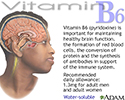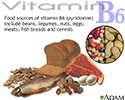Vitamin B6
Pyridoxal; Pyridoxine; Pyridoxamine
Vitamin B6 is a water-soluble vitamin. Water-soluble vitamins dissolve in water so the body cannot store them. Leftover amounts of the vitamin leave the body through the urine. That means you need a regular supply of these vitamins in your diet.
Function
Vitamin B6 helps the body to:
-
Make
antibodies
. Antibodies are needed to fight many diseases.
Antibodies
An antibody is a protein produced by the body's immune system when it detects harmful substances, called antigens. Examples of antigens include micr...
 ImageRead Article Now Book Mark Article
ImageRead Article Now Book Mark Article - Maintain normal nerve function.
-
Make hemoglobin. Hemoglobin carries oxygen in the red blood cells to the tissues. A vitamin B6 deficiency can cause a form of
anemia
.
Anemia
Anemia is a condition in which the body does not have enough healthy red blood cells. Red blood cells provide oxygen to body tissues. Different type...
 ImageRead Article Now Book Mark Article
ImageRead Article Now Book Mark Article -
Break down
proteins
. The more protein you eat, the more vitamin B6 you need.
Proteins
Proteins are the building blocks of life. Every cell in the human body contains protein. The basic structure of protein is a chain of amino acids. ...
 ImageRead Article Now Book Mark Article
ImageRead Article Now Book Mark Article - Keep blood sugar (glucose) in normal ranges.
Food Sources
Vitamin B6 is found in:
- Avocado
- Banana
- Legumes (dried beans)
- Beef and pork
- Nuts
- Poultry
- Whole grains and fortified cereals
- Corn
Fortified breads and cereals may also contain vitamin B6. Fortified means that a vitamin or mineral has been added to the food.
Side Effects
Large doses of vitamin B6 can cause:
- Difficulty coordinating movement
-
Numbness
Numbness
Numbness and tingling are abnormal sensations that can occur anywhere in your body, but they are often felt in your fingers, hands, feet, arms, or le...
 ImageRead Article Now Book Mark Article
ImageRead Article Now Book Mark Article - Sensory changes
Deficiency of this vitamin can cause:
- Confusion
- Depression
- Irritability
- Mouth and tongue sores also known as glossitis
- Peripheral neuropathy
(Vitamin B6 deficiency is not common in the United States.)
Recommendations
The Recommended Dietary Allowance (RDA) for vitamins reflects how much of each vitamin people should receive on a daily basis. The RDA for vitamins may be used to help create goals for each person.
How much of each vitamin is needed depends on a person's age and gender. Other factors, such as pregnancy and illnesses, are also important. Ask your health care provider which amount is best for you.
Dietary Reference Intakes for vitamin B6:
Infants
- 0 to 6 months: 0.1* milligrams per day (mg/day)
- 7 to 12 months: 0.3* mg/day
*Adequate intake (AI)
Children
- 1 to 3 years: 0.5 mg/day
- 4 to 8 years: 0.6 mg/day
- 9 to 13 years: 1.0 mg/day
Adolescents and Adults
- Males age 14 to 50 years: 1.3 mg/day
- Males over 50 years: 1.7 mg/day
- Females age 14 to 18 years: 1.2 mg/day
- Females age 19 to 50 years: 1.3 mg/day
- Females over 50 years: 1.5 mg/day
- Females of all ages 1.9 mg/day during pregnancy and 2.0 mg/day during lactation
The best way to get the daily requirement of essential vitamins is to eat a balanced diet that contains a variety of foods.
References
Institute of Medicine, Food and Nutrition Board. Dietary Reference Intakes: Thiamin, Riboflavin, Niacin, Vitamin B6, Folate, Vitamin B12, Pantothenic Acid, Biotin, and Choline. National Academy Press, Washington, DC, 1998. PMID: 23193625 www.ncbi.nlm.nih.gov/pubmed/23193625 .
Mason JB. Vitamins, trace minerals, and other micronutrients. In: Goldman L, Schafer AI, eds. Goldman's Cecil Medicine . 24th ed. Philadelphia, PA: Elsevier Saunders; 2011:chap 225.
Salwen MJ. Vitamins and trace elements. In: McPherson RA, Pincus MR, eds. Henry's Clinical Diagnosis and Management by Laboratory Methods . 22nd ed. Philadelphia, PA: Elsevier Saunders; 2011:chap 26.
-
Vitamin B6 benefit - illustration
Pyridoxine, or vitamin B6, boosts the manufacture of antibodies to support the immune system. Large doses of B6 can cause numbness and neurological problems.
Vitamin B6 benefit
illustration
-
Vitamin B6 source - illustration
Like most vitamins, vitamin B6 may be obtained in the recommended amount with a well-balanced diet, including some enriched or fortified foods.
Vitamin B6 source
illustration
-
Vitamin B6 benefit - illustration
Pyridoxine, or vitamin B6, boosts the manufacture of antibodies to support the immune system. Large doses of B6 can cause numbness and neurological problems.
Vitamin B6 benefit
illustration
-
Vitamin B6 source - illustration
Like most vitamins, vitamin B6 may be obtained in the recommended amount with a well-balanced diet, including some enriched or fortified foods.
Vitamin B6 source
illustration
-
Vitamin B6 (Pyridoxine)
(Alt. Medicine)
-
Possible Interactions with: Vitamin B6 (Pyridoxine)
(Alt. Medicine)
Review Date: 2/2/2015
Reviewed By: Emily Wax, RD, The Brooklyn Hospital Center, Brooklyn, NY. Also reviewed by David Zieve, MD, MHA, Isla Ogilvie, PhD, and the A.D.A.M. Editorial team.


